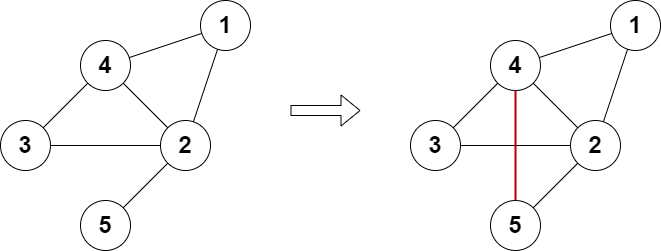Problem
There is an undirected graph consisting of n nodes numbered from 1 to n. You are given the integer n and a 2D array edges where edges[i] = [ai, bi] indicates that there is an edge between nodes ai and bi. The graph can be disconnected.
You can add at most two additional edges (possibly none) to this graph so that there are no repeated edges and no self-loops.
Return true** if it is possible to make the degree of each node in the graph even, otherwise return false.**
The degree of a node is the number of edges connected to it.
Example 1:

Input: n = 5, edges = [[1,2],[2,3],[3,4],[4,2],[1,4],[2,5]]
Output: true
Explanation: The above diagram shows a valid way of adding an edge.
Every node in the resulting graph is connected to an even number of edges.
Example 2:

Input: n = 4, edges = [[1,2],[3,4]]
Output: true
Explanation: The above diagram shows a valid way of adding two edges.
Example 3:

Input: n = 4, edges = [[1,2],[1,3],[1,4]]
Output: false
Explanation: It is not possible to obtain a valid graph with adding at most 2 edges.
Constraints:
3 <= n <= 1052 <= edges.length <= 105edges[i].length == 21 <= ai, bi <= nai != biThere are no repeated edges.
Solution (Java)
class Solution {
public boolean isPossible(int n, List<List<Integer>> edges) {
// number of edges of each node
int[] noe=new int[n+1];
// make a graph
List<List<Integer>> graph=new ArrayList<>();
for(int i=0;i<=n;i++) graph.add(new ArrayList<>());
for(List<Integer> c:edges){
int x=c.get(0);
int y=c.get(1);
graph.get(x).add(y);
graph.get(y).add(x);
noe[x]++;
noe[y]++;
}
// nodes with number of odd edges will be in the list
List<Integer> list=new ArrayList<>();
for(int i=0;i<noe.length;i++){
if(noe[i]%2==1){
list.add(i);
}
}
int odd=list.size();
//no odds
if(odd==0) return true;
else if(odd>4||odd==1||odd==3) return false; // we can't get ans with these conditions because edges will connect 2 nodes
else if(odd==4){ // if odd is 4 then we have to try out every possible combination
int node1=list.get(0);
int node2=list.get(1);
int node3=list.get(2);
int node4=list.get(3);
if(checkIfLegal(graph,node1,node2) && checkIfLegal(graph,node3,node4)) return true;
if(checkIfLegal(graph,node1,node3) && checkIfLegal(graph,node2,node4)) return true;
if(checkIfLegal(graph,node1,node4) && checkIfLegal(graph,node2,node3)) return true;
}else if(odd==2){ // if odd is 2 there are 2 conditions either join the 2 nodes with odd edges or join one node with even edge with 2 nodes with odd edge
int x=list.get(0);
int y=list.get(1);
if(checkIfLegal(graph,y,x)) return true;
for(int i=1;i<noe.length;i++){
if(i==x||i==y) continue;
if(checkIfLegal(graph,i,x) && checkIfLegal(graph,i,y)) return true;
}
}
return false;
}
// will check if there is not a repeated edge or self loop
public boolean checkIfLegal(List<List<Integer>> graph,int x,int y){
for(int val:graph.get(x)) if(val==y) return false;
return true;
}
}
Explain:
nope.
Complexity:
- Time complexity : O(n).
- Space complexity : O(n).